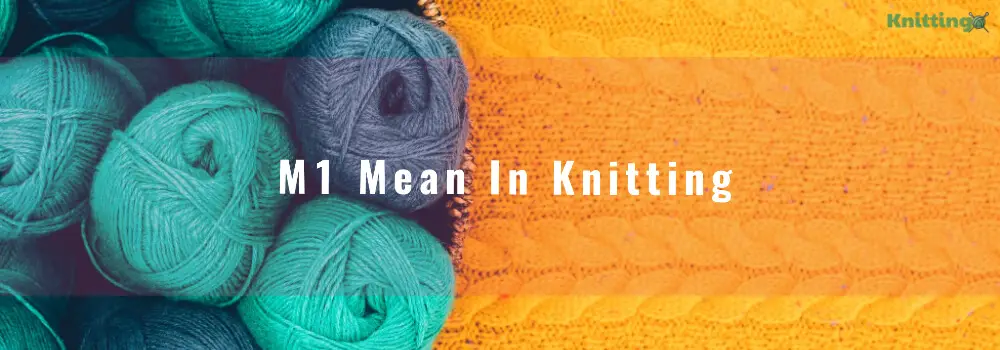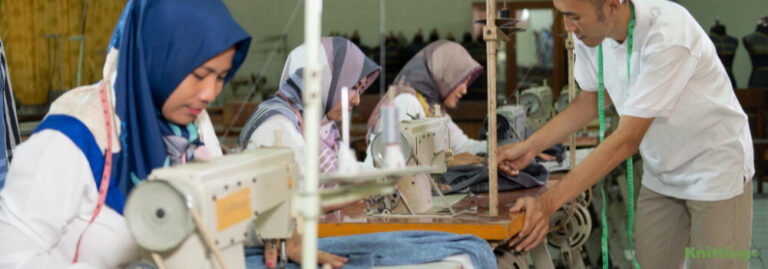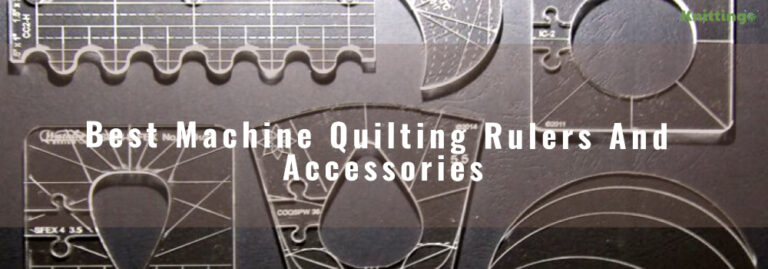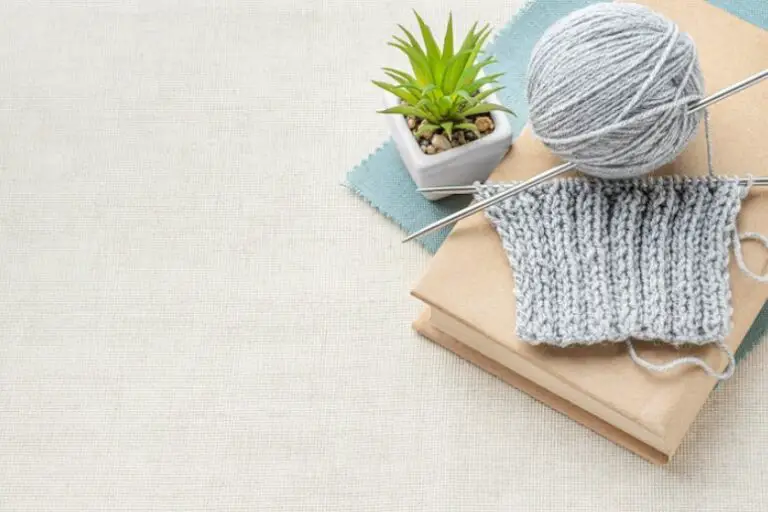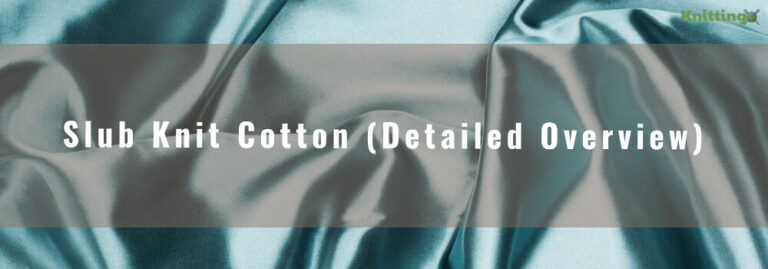M1 is an abbreviation that stands for “make 1” in knitting. “Make 1” is a common method of increasing stitches. The more you master knitting patterns, the more you will encounter m1 in your knitting projects. Since m1 is quite common, most patterns don’t even try to clarify it. As a beginning knitter, this might be a bit confusing and frustrating but don’t worry, we’ve got you covered!
If you’ve been wondering what “M1” means on a knitting pattern, then this article is for you. M1 in knitting is a method of increase that helps knitters to add one new stitch. This can be done by raising a strong of yarn into the knitting needle and making a new stitch that is different than usual. The yarn string comes through the two stitches that are already on your needle.
The M1 can be a little daunting in the beginning, but once you master it, it will come in handy in a lot of various patterns, from shawls to sweaters and any other project that involves shaping. It is advisable to learn different ways to make one. However, we have to tow major types of make-one method; they are M1R(make one right) and M1L (make one left). The make-one right increases stitches to the right, while M1L makes an increase that bends to the left.
The way the increased stitches lean isn’t that significant. Some patterns, like sweaters, might specify the lean of the increased stitch for technique elements. However, other patterns may not count on the lean of the stitch. It is advisable that you choose the pattern you like the most if the pattern does not specify the lean of the stitch for design elements. An increase is important if you want to get more stitches in knitting projects. And the most common method which knitters use to increase stitches is called make-one, normally abbreviated as M1.
Although, the most fundamental way of increasing is when you knit in the back and front of a stitch. Make-one method is usually executed in between two stitches.
| Where M1 Is Commonly Used | Other Types Of Increases You Should Know |
| Blossoms Mitts | Yarnover increase |
| Sweaters knitted from the bottom up | Twisted yarnover increase |
| A sleeve knitted from bottom up | Loop cast-on |
| Moondance shawl or the shore shawl | Front and back knitting |
| Amigurumi like Sleepy fox | Lifted increase |
How To Make The M1 Stitch
As a beginner, for you to make an M1L, you will have to take the left-hand needle and heave the bar in between the usual stitches in a front to back manner. The bar must be knitted with the right needle through the back loop.
Furthermore, there’s another type of M1 known as make-one-right. It requires you to raise the bar from the back loop and then knit it through the front loop. M1R can be a little complicated, because the pattern will not specify the type OD stitches you are supposed to perform( the pattern only says M1), meaning you can use anyone you like. If you’ve tried make-one pattern a couple of times, M1L is will be much easier.
You can work on the same stitches through the purl side. This can be done if you purl through the back loop for an M1L and through the front loop for an M1R. Knitting in the front and back pattern is more intuitive than purling in the front and back even if the two techniques are the same.
There are different manufacturers of terms, methods, and patterns may vary from what you may be knowledgeable about. So, If you want to be successful with the M1, you need to follow some tips.
1. You need to be sure you’re in line with the same increase the pattern designer intended by paying attention to the pattern instructions carefully. Note that a bar or make-one increase also means a raised or lifted increase. However, there are times where the pattern contains a list of terminologies. Most times, when abbreviations are utilized in the pattern, the designer of the pattern will give an explanation for the pattern in the notes as to the meaning of the abbreviations.
2. The two common points where knitters usually work with an M1 increase are hidden in seams and sometimes along the edge-although an increase makes it difficult to see a seam that is irregular. Whether a stitch or two in or at the edge of your knitting piece, the pattern will always show where you need to create one.
3. A “fully fashioned” increase is the alternative term used for an M1 increase. This term is usually associated with decreases or increases that involve molding so that your materials will not be excessively arranged in a bunch. Machine knitting patterns used the term more than hand knitting patterns. You can place fully fashioned increase stitches a few stitches in from the edge. These full-fashioned increases evolve to be a design element in most knitted garments, as Raglan sleeves are a typical example.
You may feel like throwing in your knitting needles when you first begin knitting with the M1. M1 is a little tight, and it can be a little complicated in your first couple of times. But once you learn and master it, you will be able to manipulate M1 in any project that you wish to make your increases unnoticed.
Where M1 is commonly used
In modern knitting pattern, M1 is a very prominent increase. Here are a few places where you might come across M1;
1. Operating a sleeve from the bottom up
2. Knitting a shawl such as Moondance shawl or the shore shawl
3. Knitting amigurumi such as the sleepy fox
4. Knitting a sweater, also from the bottom up
5. Knitting any projects that increase in size when you knit, like the Blossoms Mitts
Try to knit a few swatches when you’re ready to try the M1 and see if it’s okay before you begin any project.
M1 On The Purl Side
You can make use of the pattern instructions that we mentioned above to the purl side of your knitting project although knitting shaping is performed on the right side of the project. You will be adding a new purl stitch instead of just be adding a new knit stitch. Make use of these exact instructions. Add a new purl stitch instead of knitting a new stitch with the yarn in the front of the work.
There are some other essential increases every keen knitter should know.
Understanding knitting increases is a significant part of any knitter’s learning process. Learning how increases function and how they look like within a fabric will help you read your knitting better, understand the intents of the designer, and also make your knitting project decisions easier for you. Quickly, I will show you some of the common types of increases.
Knowing that decreases lean to either the left or the right, increases also lean to either left or right too. Therefore, you can work increases on every edge of a piece in mirrored pairs.
1. Yarnover Increase
Perhaps working a yarnover is the simplest way of adding stitches to your knitting. The yarnover increase is performed when the tight needle between two stitches is wrapped by the yarn. An eyelet or small hole is produced by this method, in knitting, so it’s commonly used in lace patterns, where hole or eyelet are preferable. Aslant is not required by a yarn over increase, so the exact method can be used at the left and right edges.
2. Twisted Yarnover Increase
The variation of the yarnover increase is known as the twisted yarnover method. It is created by preparing a yarnover on the row involving the yarnover and the increase to close the backward yarnover by the front loop slant.
3. Loop Cast-On
The loop method is another technique used for making mirrored increases. This is the exact method that knitters use to cast-on stitches for a buttonhole. It creates less space between the stitches because it utilizes a small amount of yarn than the yarnover technique.
4. Front And Back Knitting
Here’s another method used to create increases, involving using the same stitch more than a time. This is commonly done by front and back knitting on the same stitch. Horizontal at the base of the new stitch is formed through this method. Since the bar falls on the left side of the increases, it is best to make the bars align, so as to work the last k1f&b one stitch from the edge. This helps to keep the bar exact distance from the edge.
5. Lifted Increase
The last method for creating an increase from an existing stitch is what is called lifted increase. It involves creating a new stitch from a stitch in the previous row.
Final Words
We’ve reached the final session of this article, we hope you were able to find resources in your quest to know the meaning of M1 in knitting. If you have any questions or suggestions, do well to reach us.

